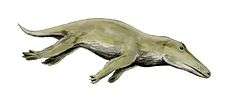Ambulocetidae
| Ambulocetidae Temporal range: Early Eocene, 53.5–48 Ma | |
|---|---|
 | |
| Ambulocetus natans | |
| Scientific classification | |
| Kingdom: | Animalia |
| Phylum: | Chordata |
| Class: | Mammalia |
| Order: | Artiodactyla |
| Suborder: | Whippomorpha |
| Infraorder: | Cetacea |
| Parvorder: | †Archaeoceti |
| Family: | †Ambulocetidae Thewissen, Madar & Hussain 1996 |
| Genera[1] | |
Ambulocetidae is a family of early cetaceans from Pakistan. The genus Ambulocetus, after which the family is named, is by far the most complete and well-known ambulocetid genus due to the excavation of an 80% complete specimen of Ambulocetus natans.[2] The other two genera in the family, Gandakasia and Himalayacetus, are known only from teeth and mandibular fragments.[3] Retaining large hindlimbs, it was once thought that they could walk on land - indeed, their name means "walking whales" -, but it is now known that they were fully aquatic like modern cetaceans.[4]
Description

The most basal of marine cetaceans, ambulocetids lived in shallow near-shore environments such as estuaries and bays, but were still dependent on freshwater during some stage of their life. Some of the characteristics related to sound transmission found in the lower jaws of modern whales that were absent in pakecetids are present in ambulocetids. They probably swam by paddling their large feet, which is not a very efficient mode of locomotion, suggesting they ambushed rather than chased prey. Ambulocetids had a narrow head with eyes facing laterally.[5] Another lineage of fully aquatic freshwater predators, the neochoristoderes such as Champsosaurus, also have forward-faced eyes, as opposed to the dorsally positioned eyes of crocodilians and other amphibious predators.[6]
Ambulocetus and Gandakasia primarily ate terrestrial prey, while a combination of low oxygene isotope and high carbon isotope values suggests that Himalayacetus consumed freshwater but ate marine prey, thus that it foraged in a marine environment but returned to freshwater to drink.[3]
Phylogeny

Ambulocetid fossils have been found in Pakistan along the former coastline of Cimmeria. The sedimentary facies in which these fossils were found indicates that ambulocetids inhabited a shallow, swampy near-shore marine environment.[7] They may have occupied a similar ecological niche to river dolphins.
The family is believed to have diverged from the more terrestrial Pakicetidae. The families Protocetidae and possibly Remingtonocetidae, are believed to have arisen from a common ancestor with ambulocetids.[8] Together with Basilosauridae, the five families are classified under the suborder Archaeoceti.[9]
See also
Notes
- ↑ Berta, Sumich & Kovacs 2006, p. 58
- ↑ Madar, Thewissen & Hussain 2002
- 1 2 Uhen 2010, pp. 201–3
- ↑ Konami Ando, Shin-ichi Fujiwara, Farewell to life on land – thoracic strength as a new indicator to determine paleoecology in secondary aquatic mammals, First published: 10 July 2016 DOI: 10.1111/joa.12518
- ↑ Thewissen & Williams 2002, pp. 78–80
- ↑ John Acorn, Deep Alberta: Fossil Facts and Dinosaur Digs, University of Alberta, 07/02/2007
- ↑ Heyning & Lento 2002, p. 54
- ↑ Thewissen 1998, p. 43
- ↑ Rose 2006, p. 273
References
- Berta, Annalisa; Sumich, James L.; Kovacs, Kit M. (2006). "Cetacean Evolution and Systematics". Marine Mammals: Evolutionary Biology. Academic Press. ISBN 978-0-12-088552-7.
- Heyning, J.E.; Lento, G.M. (2002). "The Evolution of Marine Mammals". In Rus Hoelzel, A. Marine Mammal Biology: An Evolutionary Approach. John Wiley & Sons. ISBN 978-0-632-05232-5.
- Rose, Kenneth David (2006). The Beginning of the Age of Mammals. JHU Press. ISBN 978-0-8018-8472-6.
- Madar, S.I.; Thewissen, J.G.M.; Hussain, S.T. (2002). "Additional holotype remains of Ambulocetus natans (Cetacea, Ambulocetidae), and their implications for locomotion in early whales". Journal of Vertebrate Paleontology. 22 (2): 405–22. doi:10.1671/0272-4634(2002)022[0405:AHROAN]2.0.CO;2. OCLC 4630509456.
- Thewissen, J.G.M. (1998). The Emergence of Whales: Evolutionary Patterns in the Origin of Cetacea. Springer. ISBN 978-0-306-45853-8.
- Thewissen, J.G.M.; Madar, S.I.; Hussain, S.T. (1996). Ambulocetus natans, an Eocene cetacean (Mammalia) from Pakistan. Courier Forschungsinstitut Senckenberg. 191. pp. 1–86. ISBN 9783929907322. OCLC 36463214.
- Thewissen, J.G.M.; Williams, E.M. (2002). "The Early Radiations of Cetacea (Mammalia): Evolutionary Pattern and Developmental Correlations" (PDF). Annual Review of Ecology and Systematics. 33: 73–90. doi:10.1146/annurev.ecolsys.33.020602.095426. OCLC 4656321698. Retrieved February 2013. Check date values in:
|access-date=(help) - Uhen, Mark D (2010). "The Origin(s) of Whales". Annual Review of Earth and Planetary Sciences. 38: 189–219. Bibcode:2010AREPS..38..189U. doi:10.1146/annurev-earth-040809-152453.